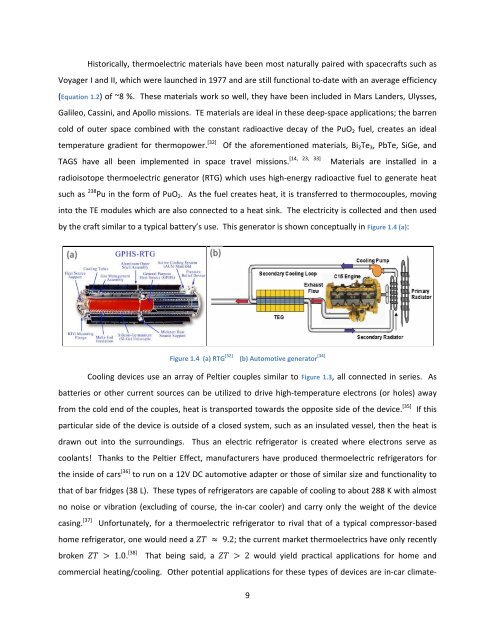Exploration and Optimization of Tellurium‐Based Thermoelectrics
Exploration and Optimization of Tellurium‐Based Thermoelectrics
Exploration and Optimization of Tellurium‐Based Thermoelectrics
You also want an ePaper? Increase the reach of your titles
YUMPU automatically turns print PDFs into web optimized ePapers that Google loves.
Historically, thermoelectric materials have been most naturally paired with spacecrafts such as<br />
Voyager I <strong>and</strong> II, which were launched in 1977 <strong>and</strong> are still functional to‐date with an average efficiency<br />
(Equation 1.2) <strong>of</strong> ~8 %. These materials work so well, they have been included in Mars L<strong>and</strong>ers, Ulysses,<br />
Galileo, Cassini, <strong>and</strong> Apollo missions. TE materials are ideal in these deep‐space applications; the barren<br />
cold <strong>of</strong> outer space combined with the constant radioactive decay <strong>of</strong> the PuO2 fuel, creates an ideal<br />
temperature gradient for thermopower. [32] Of the aforementioned materials, Bi2Te3, PbTe, SiGe, <strong>and</strong><br />
TAGS have all been implemented in space travel missions. [14, 23, 33] Materials are installed in a<br />
radioisotope thermoelectric generator (RTG) which uses high‐energy radioactive fuel to generate heat<br />
such as 238 Pu in the form <strong>of</strong> PuO2. As the fuel creates heat, it is transferred to thermocouples, moving<br />
into the TE modules which are also connected to a heat sink. The electricity is collected <strong>and</strong> then used<br />
by the craft similar to a typical battery’s use. This generator is shown conceptually in Figure 1.4 (a):<br />
Figure 1.4 (a) RTG [32] (b) Automotive generator [34]<br />
Cooling devices use an array <strong>of</strong> Peltier couples similar to Figure 1.3, all connected in series. As<br />
batteries or other current sources can be utilized to drive high‐temperature electrons (or holes) away<br />
from the cold end <strong>of</strong> the couples, heat is transported towards the opposite side <strong>of</strong> the device. [35] If this<br />
particular side <strong>of</strong> the device is outside <strong>of</strong> a closed system, such as an insulated vessel, then the heat is<br />
drawn out into the surroundings. Thus an electric refrigerator is created where electrons serve as<br />
coolants! Thanks to the Peltier Effect, manufacturers have produced thermoelectric refrigerators for<br />
the inside <strong>of</strong> cars [36] to run on a 12V DC automotive adapter or those <strong>of</strong> similar size <strong>and</strong> functionality to<br />
that <strong>of</strong> bar fridges (38 L). These types <strong>of</strong> refrigerators are capable <strong>of</strong> cooling to about 288 K with almost<br />
no noise or vibration (excluding <strong>of</strong> course, the in‐car cooler) <strong>and</strong> carry only the weight <strong>of</strong> the device<br />
casing. [37] Unfortunately, for a thermoelectric refrigerator to rival that <strong>of</strong> a typical compressor‐based<br />
home refrigerator, one would need a 9.2; the current market thermoelectrics have only recently<br />
broken 1.0. [38] That being said, a 2 would yield practical applications for home <strong>and</strong><br />
commercial heating/cooling. Other potential applications for these types <strong>of</strong> devices are in‐car climate‐<br />
9
















